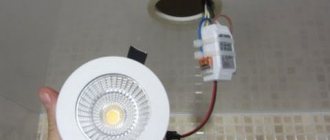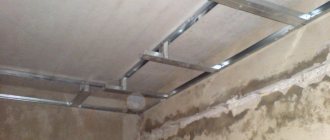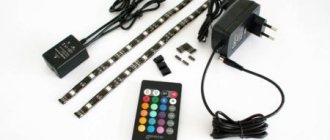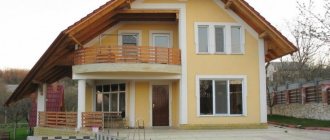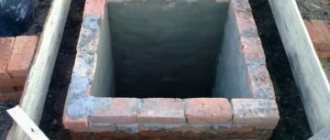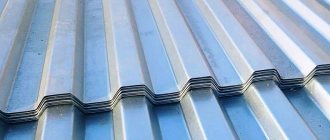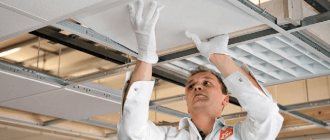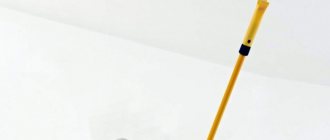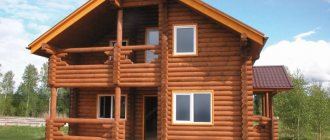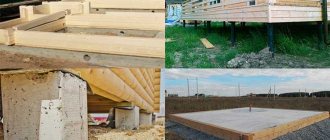Tension fabric is the most promising material for decorating the ceiling space in an apartment or office. It provides a perfectly flat surface, has high performance characteristics and durability. Installation of a stretch ceiling is possible in renovated premises; it is carried out within 2-3 hours, does not involve wet processes and does not require a radical rearrangement of furniture. A variety of textures and colors, multi-level designs, prints and the use of special effects create unlimited possibilities for design solutions. Which canvas is better to choose? When purchasing, you should focus on the specifics of the premises, personal preferences and financial capabilities.
1.
Pros and cons of suspended ceilings
Advantages and disadvantages are determined by the type of coating used - PVC film or fabric ceilings.
But there are a number of common advantages:
- Finishing speed. Films are stretched for 4-10 hours, fabric - 5-12 hours.
- Saving the interior. Film coatings are capable of retaining large masses of water for a long time; fabric material is less waterproof, but can prevent the risk of spillage for 2-3 hours.
- There is no need to carry out leveling work on the ceiling plane. All defects, as well as communication pipes and beams in private houses, will be covered with canvas.
- Insulation and insulation materials can be laid under PVC and woven suspended ceilings.
Versatility. You can stretch fabrics in any room or building
It is important to choose materials that provide the desired level of comfort and meet the stated requirements for the use of space. Easy to care for. Cleaning is required no more than once every 6 months
Dry, wet cleaning is sufficient. If persistent stains appear, use conventional non-aggressive detergents.
Variability of color solutions, design formation, affordable price are additional advantages of finishing. It is also worth noting the long service life of the canvases, environmental friendliness and the possibility of using finishing in rooms with high requirements for the cleanliness of facing materials - in children's rooms, hospitals and other facilities.
The disadvantages of suspended ceilings depend on the type of fabric chosen:
- film coverings cannot be installed in open spaces in areas with a possible decrease in temperature;
- It is better not to use fabric sheets in rooms with high humidity levels;
- PVC films for ceilings are welded to be stretched over large areas;
- The maximum power of luminaires for suspended ceilings is no more than 40 watts; installation of a thermally insulating lampshade is mandatory.
When considering the pros and cons of suspended ceilings, it should be noted that it is necessary to involve a specialist to carry out the finishing. Do-it-yourself tensioning is possible, but the master will need special tools and experience, and no one can guarantee high-quality tension. It’s easier to use the services of professionals and get guarantees for all types of work.
Where are stretch ceilings used?
High-quality suspended ceilings can be used in any buildings, houses, rooms, but there are some peculiarities - films are best used in warm spaces, but woven fabrics are best used in areas with minimal moisture content, but woven materials do not deteriorate under the influence of negative temperatures.
Application area:
- private houses made of any materials;
- apartments;
- warehouse and public buildings;
- offices;
- commercial buildings;
- construction of entertainment complexes, including swimming pools, sports and concert halls;
- educational institutions and others.
There is not a single building where tension fabrics cannot be used. Fabric materials will be an ideal solution for open areas of balconies, loggias, terraces, as well as in storage rooms, basements and underground parking lots. The structures are lightweight and do not weigh down floor slabs or load-bearing beams. If the choice is made correctly, the owner receives a fireproof, environmentally friendly and aesthetic coating that will last for several decades without the need for repairs or renovation of the ceiling surface.
Type of canvas
To make a suspended ceiling, you can use one of the following materials:
- Polyvinyl chloride film with a thickness of 0.15-0.35 millimeters. It is considered the most affordable and popular choice for finishing the ceiling.
- Polyester fabric with a thickness of 2.25 millimeters, which is impregnated with polyurethane. Its main difference is its environmental friendliness and the ability to carry out seamless installation in large rooms. As a rule, environmentally friendly stretch ceilings are more in demand among buyers.
- Fiberglass. This is a durable, moisture-proof canvas that serves as the basis for painting. Rarely used.
Despite the similarity of characteristics of the above materials, they have differences that affect their scope of application:
- Appearance
. The film fabric is made glossy, matte or satin, and the texture of the fabric is exclusively matte. - Strength indicators
. The fabric material has better resistance to damage caused by sharp objects than PVC film. - Frost resistance
. In conditions of negative temperatures, polyvinyl chloride fabric becomes brittle and begins to crack. In turn, the fabric can withstand even minus 35 degrees and therefore is installed in unheated rooms. - Water resistance
. For film canvases this figure is much higher. They should be installed where there is constant high humidity. - Environmental friendliness
. All materials for suspended ceilings are absolutely safe for people. The presence of micropores in the fabric structure ensures air ventilation and, accordingly, a healthy microclimate in the room, so it is often chosen when it is necessary to decide which stretch ceilings are best installed in a nursery.
Their PVC fabrics differ:
- high water resistance;
- variety of textures;
- affordable cost;
- possibility of re-installation.
But polyvinyl chloride film also has disadvantages:
- the material does not breathe;
- not suitable for rooms where it is cold.
Polyester fabrics are resistant to sub-zero temperatures and are environmentally friendly. But they are expensive and are not suitable for rooms with constant air humidity. Fiberglass is characterized by mechanical strength and the possibility of reusable image application, but it requires additional painting.
The ceilings are suture and seamless.
The presence or absence of seams also determines how stretch ceilings differ from each other. Traditionally, suture ceilings are made only from PVC film, the width of which is no more than 2 meters. In seam structures, strips of PVC sheets are welded together using a special technology: a seam is formed at the welding site, which is hardly noticeable on matte and satin ceilings and is almost invisible on glossy structures.
Installation of suture ceilings is carried out using a heat gun, with the help of which the polyvinyl chloride sheet is heated to a temperature of +55... +60 ° C and stretched to the desired size. Despite the presence of a seam, such ceilings are exceptionally moisture resistant, as they can hold up to 100 liters of water in one square meter. In addition, such ceilings do not require any special care, but have excellent decorative properties.
Until some time, only structures made of fabric were considered seamless ceilings, but several years ago seamless structures made of PVC film began to be installed in the homes of our compatriots. Seamless PVC ceilings have all the same advantages as ceilings with seams, but are more expensive.
As for fabric ceilings, they can withstand low temperatures, so they can be used even on closed terraces, loggias, balconies and in houses with seasonal residence. It is impossible not to mention the high strength of such ceilings.
Types of materials for suspended ceilings
The design is a thin canvas stretched over a frame fixed around the perimeter of the room. The material is:
- film (contains polyvinyl chloride);
- fabric - made of polyester impregnated with polyurethane.
These materials differ in properties and installation features. Before installation, PVC is heated to 70º C. The film increases in volume, after which it is fixed to the frame. The canvas cools and stretches. The fabric does not require heating; it is simply attached to the baguette.
Technical characteristics also differ:
- Operating temperature for fabric is from -50º to +100ºC, and for film - from -5º to +50ºC.
- Fire safety. Both materials do not burn, but vinyl melts near fire and at high temperatures.
- The thickness of PVC is 0.15-0.5 mm, polyester - 0.15-0.25.
- The weight of a square meter of film is from 180 to 325 grams, and of fabric - about 200.
- PVC is completely waterproof, while polyester is partially waterproof. With prolonged contact with water, polyurethane impregnation gradually loses its properties. The liquid is retained for no longer than two hours. In the future, divorces may appear.
- Polyester fabric is breathable, but film is not.
- Polyester stretches up to 120%, and PVC - up to 220%.
- The sound insulation coefficient is up to 0.6 for fabric and up to 0.4 for film.
What kind of suspended ceilings can you make with your own hands?
There are two types of suspended ceilings:
- Film.
- Fabric.
The main difference is the material of the canvas. In the first case, a thin polyvinyl chloride film is used, in the second, a synthetic fabric made of polyester impregnated with polyurethane. Each material has both pros and cons.
The main advantages of PVC film:
- waterproof - when flooded, the suspended ceiling retains water, and after the liquid is drained, it returns to its previous appearance;
- many color variations - more than 250 shades of various textures are available (glossy, matte, satin, textured, with patterns or photo printing);
- the ability to carry out wet cleaning - thanks to this, the ceiling is easy to care for and remove even the most stubborn stains.
Advantages of fabric sheets:
- frost resistance - polyester can withstand negative temperatures down to -50ºC without losing properties;
- large width of the canvas - 5.1 m versus the maximum 3.2 m for film, which allows you to make seamless ceilings in almost any room;
- durability - withstands an accidental blow or a flying champagne cork;
- breathability - thanks to microscopic holes in the structure of the material, the canvas does not interfere with air exchange in the room.
The disadvantages of film ceilings include low strength - PVC breaks from contact with sharp objects and does not tolerate negative temperatures. The main disadvantages of fabric canvases are the high cost and a modest selection of colors - only about 20 shades of mostly pastel colors.
Installing a suspended ceiling with your own hands is possible for both options, but there is a difference in installation technology. PVC film is preheated so that the material becomes elastic and stretches. For this, a gas heat gun is used. After cooling, the film stretches and forms a flat surface. The polyester fabric does not require heating and immediately after installation it has a finished appearance.
Previously, we have already described in detail the technology for installing a fabric stretch ceiling; in this article we will look at how to stretch a PVC fabric.
Texture of materials for suspended ceilings
Fabric ceilings always have a matte texture. The reflective properties of PVC sheets range from 5 to 70 percent. The choice of material depends on the purpose of the room and the individual preferences of the owner of the property.
Externally, matte ceilings look like a high-quality plastered surface. People with refined taste prefer this kind of discreet elegance. Matte finishes look good in brightly lit and spacious rooms. They are combined with an interior decorated in a classic style, where there is stucco molding, columns and antiques. Canvases in pastel colors are popular.
In modern interiors, glossy stretch coatings are the most appropriate. They are preferred by people with an active, innovative position. The use of such material helps to visually enlarge the room, so it is often installed in small rooms. Glossy canvases are sold in a wide range of colors. The richer the shade of the canvas, the better its reflective properties will be.
Satin
This type of canvas is an imitation of fabric with a weak texture. There is a slight shine, but less than gloss. In appearance it occupies an intermediate position between glossy and matte ceilings. Satin gives the room some elegance. If the surface is colored, the shade changes depending on the lighting and viewing angle.
Perforated
Holes are made in the canvases. They can be of different shapes and sizes, arranged randomly, in straight lines, or in patterns.
The material used for artistic perforation is PVC film, usually with a glossy texture. The fabric is used only for microperforation, which improves the soundproofing properties of the fabric. Perforated ceilings are combined with lighting, which creates an unusual decorative effect.
Translucent
The canvas is a special translucent film that transmits light well. Light bulbs are installed between the suspended and main ceilings. As a result, it appears that the entire surface is glowing. A similar effect is also achieved when using fabric with microperforation.
Texture
In addition to the listed textures, canvases are produced with imitation suede, marble, mother-of-pearl or wood, as well as with a metallic or silk sheen.
Combined
For greater expressiveness and zonal delimitation of space, different types of textures are combined with each other. But when combining, you need to consider how the ceiling will look with the rest of the interior and furniture.
Forms of tension fabrics
Using different types of stretch fabrics, you can create a wide variety of shapes.
Direct
The most traditional and classic option, which, despite its simplicity, looks very elegant. The straight ceiling plane forms strict and clear interior lines.
The photo shows a living room with a straight white stretch ceiling.
Conical shape
A decorative element in the form of a conical shape with a drop-shaped or truncated end allows you to place accents on the ceiling space or hide various defects. A cone with original lighting or a chandelier will become a unique art object for the entire room.
In wave form
This design can have different sizes and colors, and differ in synchronous, cut or smoothly decaying wave periodicity. Such wavy patterns give the room a specific style.
Arched
Semicircular ceiling shapes will give the interior more softness, calmness and coziness. Arched vaults create a smoother transition between the ceiling and the walls.
Dome shaped
Tension products in the form of a dome can completely change the perception of the ceiling plane and add three-dimensional volume to it. This form looks especially surprising and impressive in a glossy design.
Variety of canvas shapes
For those who are bored with the usual unremarkable ceiling, curly models are suitable. PVC film is so elastic that it allows you to create any unusual shapes.
Direct
A straight stretch ceiling is suitable for those who are not ready to experiment. This is a classic option. It looks simple, elegant and modest. Clear lines and deliberate severity will add chic to the interior. A glossy or matte ceiling can be straight.
Arched
An arched stretch ceiling makes the room round. Soft smooth lines give comfort and special charm. This design looks impressive only in a spacious room.
You can round corners on one or more sides. It will be possible to use canvases of various textures and colors. Thanks to this, you will get a unique interior that will attract attention.
Wave
This form of stretch ceiling, reminiscent of a wave, will look great in a bathroom or room with a swimming pool. The bends can be symmetrical or not, localized only on one side or over the entire surface. Everything depends only on the imagination of the apartment owner. Any idea can be realized.
A matte wave-shaped ceiling does not look so original, so it is better to give preference to gloss. It will create numerous highlights on the surface, which will enhance the volume effect.
Conical
It is worth choosing a cone-shaped suspended ceiling for a spacious hall with columns. It will complement the interior and emphasize its sophistication. This coating looks unusual, and therefore it is not always appropriate to use it in an average apartment.
Fabric ceilings
This type of ceiling began to be used relatively recently - as soon as manufacturers learned to process the fabric in such a way that it acquired the necessary strength and extended its service life. After impregnation of the fabric with a special composition, it acquired special strength and resistance to physical influences, while retaining the appearance of textiles.
Fabric coverings have a number of advantages:
- The fabric fits more harmoniously into the interior, creating a special coziness and comfortable microclimate.
- Impregnations that make the fabric more durable are harmless to health.
- The fabric, due to its porous structure, allows air to pass through, giving the surface the opportunity to “breathe”.
- This fabric can reach a width of 5 meters, which allows you to create a solid ceiling without seams even in spacious rooms.
- Ceilings made of this material fit perfectly into any interior style, making it more respectable and expensive.
- Fabric, unlike film coatings, tolerates low temperatures well. Therefore, it is often used for finishing unheated rooms used only during the warm season.
- Simple and quick installation. To install them, a heat gun is not required, as for PVC film, so you just need to assemble the frame, moisten the canvas with water and stretch it over the frame.
On a note! When choosing fabrics, it is important to consider the functional purpose of the room.
Disadvantages of fabric sheets:
- Since the material has a porous structure, it becomes clogged with dust faster. Despite the dust-repellent impregnation, it will have to be cleaned more often than PVC film.
- Fabric versions of suspended ceilings are prone to absorbing odors, so using them in the kitchen is not recommended.
- Fabric ceilings are more expensive than other analogues.
Manufacturing company
In many ways, the quality and price of a ceiling structure depend on the company that produces the product. It is believed that the best suspended ceilings are made by European companies.
Canvases from Europe today occupy the majority of the domestic market. Matte and glossy canvases from these countries are of high quality, but French companies have remained trendsetters for many years. The cost of their products is higher compared to the prices of Russian and Chinese similar products.
In Russia, the production of tension fabrics is still in its infancy. The leading position is occupied by the company Saros Design, whose production facilities are located in Moscow. Its products are represented by canvases of different sizes and colors.
Traditionally, Chinese materials for suspended ceilings are either of excellent quality, not much inferior to European goods, or fakes. The leading companies are: HALEAD, Gline, MSD. Their tension fabrics are considered worthy competitors to the world leaders in the industry, but they are much cheaper.
European stretch ceilings
Canvases from Europe occupy the largest segment of the market. Manufacturers offer a wide range of glossy and matte ceilings of the highest quality, and French companies are trendsetters. The cost of European products is significantly higher than their Russian and Chinese counterparts.
Well-known companies: Barrisol, Alkor Draka, Extenzo, Newmat, Clipso (France), Poliplast (Belgium), Renolit, Pongs, Descor, Lackfolie (Germany), Cerutti (Italy).
Russian stretch ceilings
In Russia, the production of suspended ceilings is still poorly developed. The industry leader is Saros Design, which founded production in Moscow in 1996. Today, the company has production facilities in a number of Russian cities, Kyiv, Narva, and Stuttgart. The company offers canvases in a wide range of sizes and colors, applies drawings, and makes computer calculations using its own program.
Budget buyers can choose stretch ceilings produced by the Kazan Artificial Leather Plant and Ivanovo NIIPIK. Enterprises produce canvases up to 1.4 m wide in a limited range of colors.
Chinese stretch ceilings
The range of Chinese goods is traditionally heterogeneous. Here you can find both materials that are not inferior in quality to their European counterparts, as well as outright fakes. Industry leaders include the following companies: MSD, HALEAD, Gline. Stretch ceilings from these manufacturers compete with world leaders and are much cheaper.
4.
Design differences
When comparing the operational, cost and aesthetic characteristics of two ceiling space design systems, you must first understand the difference in design between a stretch and suspended ceiling. This will allow you to more accurately perceive the parameters being compared.
The main difference between a suspended ceiling and a suspended ceiling is the fastening system. The tension fabric is attached to baguettes fixed along the perimeter of the walls - PVC film or fabric is stretched between them (hence the name - tension).
The suspended ceiling is mounted from sheets of plasterboard to a rigid suspended frame (can also be slatted), fixed not only to the walls, but also with the help of special hangers, to the ceiling - hence the suspended ceiling.
From the above definitions, three more differences can be distinguished:
- the suspended ceiling has a hard surface; under certain conditions, a suspended ceiling can sag significantly, for example, when water gets in from the roof or from neighbors above;
- the plasterboard with which the frame of the suspended ceiling is sheathed can withstand various mechanical loads: shocks, scratches, cuts, etc., PVC film or synthetic fabric (polyester) can tear from a light touch of a sharp object;
- The damaged surface of a suspended ceiling can be easily repaired, up to the replacement of a separate element; for a tension ceiling, the entire panel must be replaced.
Color palette of suspended ceilings
Due to the fact that stretch fabrics come in different colors and shades, every homeowner can realize the most unusual design ideas. It must be remembered that the appearance of the ceiling surface has a strong psychological impact on residents.
Different colors transform the appearance of rooms in their own way:
- White color is considered traditional when finishing the ceiling surface. It visually increases the height of the ceilings and is suitable for interiors decorated in different styles. White color and discreet pastel colors look great in the living room, bedroom, kitchen, hallway and other rooms. If desired, photo printing is applied to a light matte panel.
- Bright colors look good in nurseries, filling their space with joy and energy.
- Rich shades are often chosen for the bathroom or kitchen.
- For the bedroom, the best solution would be calm colors - beige, pink and blue.
- A brown, but not very dark, ceiling will help create a business atmosphere in the office.
- The color red, according to psychologists, has many qualities, including those that cause aggression. When creating the interior of an apartment, it is recommended to use it in the form of small-sized inserts.
- Steel, dark purple and black glossy ceiling surfaces can add originality to high rooms. Dark-colored canvases are used to create the “starry sky” effect.
When arranging multi-tiered ceiling structures, they often combine different textures and colors, achieving an original result due to contrast.
Stretch or suspended ceilings
For those who have not yet decided for themselves which is better - a suspended ceiling or a suspended one, we will try to make the task easier through a brief comparative analysis:
- Stretch ceilings are good, first of all, for their irresistible appearance and comparative speed of installation, but installation can only be carried out with the involvement of third-party specialists due to the complexity of the technology (see Advantages of stretch ceilings: again about the good).
- Suspended ceilings can be installed independently, and they have virtually no restrictions on complexity. However, they cannot boast, for example, of the ideal gloss inherent only to film stretch fabrics (see Aluminum suspended ceilings - types, scope, installation features).
Combination of a suspended ceiling with a suspended ceiling in a two-level ceiling structure
- When determining which is better - a suspended or suspended ceiling, in each specific case you should take into account the characteristics of the room. Thus, stretch ceilings are usually used for luxury modern interiors, but, for example, they are not suitable for outdoor rooms and rooms without heating, since they become brittle at low temperatures, which cannot be said about suspended systems.
- It is advisable to use suspended ceilings in the decoration of large premises - offices and other institutions; moreover, such systems look more strict.
Design options
Another classification option is by the number of levels of the structure. The ceiling may consist of one, two or several tiers. The more there are, the more complex and expensive the production and installation.
Single-level
These are ordinary ceilings. The frame of profiles is fixed at the same height, the canvas is stretched over the entire area. Installed in 2-3 hours. If the width is not enough, the individual parts are connected with a seam. The shape follows the configuration of the walls, taking into account niches and projections.
With this design there is less loss of height. Therefore, single-level ceilings are recommended for low rooms.
Multi-level
Such designs allow you to divide the space into separate zones and place accents. Multi-level ceilings are also used to hide forced ventilation ducts.
The profiles make up a complex structure. The canvases are stretched at different heights. Installation takes longer and costs more.
It must be taken into account that the ceiling height is reduced. Therefore, such designs are suitable for rooms above 2.7-2.8 meters.
The ceiling can combine different colors and types of textures. For example, smooth and matte or translucent and opaque. Several tiers also allow you to combine different lighting options: chandelier, perimeter lighting, built-in lamps, etc.
Basically, two-level ceilings have become widespread. They are installed in halls and kitchen-living rooms. Three, four or more levels look good only in very high rooms (the combined first floor of a cottage, a commercial play area).
Installation principle
The preliminary stage is the development of the design of the future ceiling. IT is required for complex options - multi-tiered, with unusual shapes, “starry sky”.
Before starting work, measurements are taken using tape measures and levels. The fabric is made from them in production - the strips are cut, welded and, if necessary, a harpoon is welded.
Then the places where the baguette will be attached are marked on the site. To avoid damaging pipes or wires that are located in the thickness of the wall, use a metal detector. The profiles are secured using self-tapping screws and plastic dowels with a hammer drill, drill or screwdriver.
The next stage is stretching the fabric. The film is straightened and heated with a heat gun. There is no such need for fabric. The material is fixed in the corners, and then around the perimeter, tucked into the baguette with a special spatula. Multi-tiered structures are installed in several stages. And if the “starry sky” ceiling type is chosen, a platform for the generator is first made above the main level. Fiber optics or LEDs are drawn from it. Later they are attached with silicone glue or passed through prepared holes in the canvas.
The installation time depends on the complexity of the structure and the area of the room. A single-tier ceiling in a medium-sized room (15-20 square meters) will be ready in 2-4 hours. The time increases if the height of the room is more than 3 meters or many lamps are required (installation of each takes from 20 minutes). Multi-tiered structures with complex lighting can be installed within several working days.
Stretch ceilings are a popular and modern type of decoration. They are durable and incredibly versatile; they will fit well into a classic office, a cozy nursery or a luxurious hall. It is possible to install a tension structure both during a major overhaul and after its completion, and installation of a typical project takes only a few hours.
Varieties according to the integrity of the canvas
Depending on the size of the canvas, products are divided into two types.
Seamless
This type of tension fabric is characterized by the absence of a welded seam. This solid surface has a more aesthetic appearance and is quite practical.
With seam
They look no less attractive and beautiful. When the light is directed at the right angle, the weld seam will be almost invisible.
Options for the presence of a gap between the wall and the canvas
There are two main types.
Gapless
Such models fit tightly to the wall without the use of decorative tape, which creates an absolutely perfect appearance for the ceiling.
With a gap
The gap formed during installation between the wall and the canvas makes the appearance of the structure unfinished. Therefore, it is very often decorated with decorative tape, braid or ceiling plinth.
Options for fastening the canvas
A stretch ceiling cannot be fixed with nails, screws or anything similar - the fabric or film will be damaged. A special frame is made from a profile to which the canvas is attached.
Aluminum or plastic is used to make fasteners. The first is required for large rooms (from 50 square meters), as it better withstands strong tension. Both options are suitable for medium and small rooms.
Several types of fastening of suspended ceilings have been developed, differing in shape and design:
- harpoon;
- wedge or glazing bead;
- clip-on
Harpoon
With such a fastening system, an accurate calculation of the area of the future ceiling and preliminary preparation of the canvas are required. A special plastic edge is welded to the edge of the PVC film - a harpoon, which is then inserted into the hole of the baguette.
This installation method allows you to remove the film and attach it back. This makes it easier to access the space behind the ceiling. There may be lighting fixtures, generators and converters, air ducts, etc. The film is also removed in order to drain water after a flood.
Beading
Wedge and glazing bead fastenings are similar to each other. The film is cut with a margin (about 7-13%). The edges are inserted into the profile holes and secured with a plug. The part is produced in the form of a wedge or bead. The name is determined depending on the type.
With this method, excess fabric remains at the edges, which is cut off or hidden behind a soft ceiling plinth. Installation is simplified, since no preliminary preparation is required, and the calculation may not be as accurate. But the removed film cannot be reattached.
Clip-on
For fabric ceilings, a clip fastening is used, which is also called “cam” or “Clipso”. The fixation acts like a clothespin into which the edge of the canvas is inserted.
Differences between suspended ceilings according to the method of fastening
In principle, the installation of all types of suspended ceilings is carried out almost the same way - a special profile called a baguette is installed along the entire perimeter of the ceiling, in which the tension fabric is fixed. The fundamental difference lies in the design of this profile, which determines two types of fastening - harpoon and harpoonless.
- In the first case, the canvas is held in the baguette due to a specially welded strip of thick PVC film and its tension.
- In the second case, the film is fixed using a special groove made according to the clothespin principle.
The first method of fastening the tension fabric is typical exclusively for ceilings made of polyvinyl chloride film, and the second is used for both PVC and fabric ceilings.
Seamless fabric stretch ceilings photo
The main difference between these two methods of fastening suspended ceilings is that it is impossible to carefully dismantle the canvas installed without a harpoon - it can only be cut out, and the profiles can be unscrewed and thrown away. The harpoon method of fixing the tension film involves its careful dismantling and reuse of already installed baguettes.
There is a third method of attaching the tension film - wedge. Currently, such fastening is practically not used - it is also classified as a harpoonless fastening system.
Types of suspended ceilings by mounting method
How to choose a panel taking into account the characteristics of the room
The right choice can only be considered one that takes into account all the features of the room where the product will be located. The following points need to be taken into account:
Room dimensions
Small spaces are good because you can use any type of canvas to decorate them. The average width of polyvinyl chloride is from 150 to 350 cm, so for installation in large halls you will need to make seams. Two sheets are welded under high pressure using a special apparatus. As a result, the seam becomes very strong and does not come apart under any circumstances. However, it may be noticeable. This is the weak point of films.
There are varieties up to 600 cm wide, but their cost is much higher. The fabric is used in any room, since its standard width is about 500 cm. This is quite enough to make a seamless tension system. In addition, making seams on such a surface is impossible.
Color film inserts look very good in multi-level designs
Features of the microclimate
Each room in the apartment has its own microclimate. This also needs to be taken into account when choosing. We have presented the most significant factors in table form.
| PVC film | Textile | |
| Humidity | Insensitive to water, can be used in the bathroom, kitchen, etc. | When exposed to moisture, it loses its attractive appearance and sometimes stretches. |
| Negative temperatures | Loss of elasticity at -5C. As a result, cracking and warping. | Insensitive. |
| High temperatures | Exceeding 70C causes melting and stretching. Indelible stains may appear. | Insensitive. |
| Draft | Over large areas, noticeable waves may appear when air moves. | Waves appear extremely rarely. |
| Ultraviolet | Retains color and does not fade for at least 10 years. | Does not fade for at least 10 years. |
Another important aspect is fire safety. High-quality coatings of any kind do not support the combustion process. They smolder and die out because they are impregnated with fire retardants. This must be confirmed by certificates. Low-quality panels burn and may release toxic substances.
Film and fabric retain color for a long time and do not fade for ten years or more
terms of Use
The film coating is very easy to care for. Dirt can be easily washed off with a soft cloth soaked in soapy water. Under normal conditions, but not in the kitchen or bathroom, it is wiped down once every year or two. The canvas is resistant to strong impacts from blunt objects, but sharp ones leave punctures or cuts. PVC can withstand even heavy leaks from above, up to 100 liters per square meter. m, after removing the liquid it takes its previous shape. It can be chosen for any room.
The fabric is more capricious. It cannot be washed; dirt is very difficult to remove. But it is resistant to mechanical damage, including impact from sharp objects. With special impregnation, it can retain water for up to 3 days. After its removal, indelible stains remain on the surface. Therefore, you have to paint the material or install a new one. Not suitable for rooms with high humidity and risk of leaks.
For the kitchen it is better to choose a stretch ceiling made of film, because it is very easy to care for
Comparison of both systems according to basic parameters
Having an idea of how the design of tension and ceiling suspension systems looks structurally, you can try to compare them according to the main parameters. Let’s take for comparison the most common type of ceiling design, stretch ceilings made of PVC film and plasterboard structures. The comparison criteria are as follows:
- Difficulty of installation;
- Loss of indoor height;
- Possibility for installation of lighting equipment;
- Aesthetic qualities;
- Operation and care.
Difficulty of installation
Simplicity and speed of installation are one of the main criteria used for comparison. If we talk about tension systems, then installation will require skill and experience. It’s rare that you can properly make such a ceiling yourself without involving specialists. However, in technological terms, installing a stretched fabric on the ceiling is much easier and faster. There is no need to remove all the furniture from the room, and installation time will take two or three times less than working with a hanging system.
You can install plasterboard ceilings yourself, but in this case a lot of work has to be done, both preparatory and basic. In terms of installation speed, frame structures are significantly inferior to working with tensioned fabric. If in the first case we can talk about one-day work, then with the installation of the frame and the installation of plasterboard fragments, the entire process can take 2-3 days.
The more complex the design (two-level or multi-level), the longer it will take to install a plasterboard ceiling.
Indoor height loss
In any case, a suspended or suspended ceiling will steal precious centimeters of room height from you. The thing is that both the first and second options involve the creation of an inter-ceiling space used technologically. Both ceilings hide defects in panel ceilings and provide the necessary space for laying communications and installing lamps.
However, the height parameters for each ceiling are different. A stretched canvas will steal only 4-5 cm, while a plasterboard ceiling will eat up 12-15 cm of useful internal space. This is where the scope of application of ceiling structures comes from. Stretch ceilings can be installed in any room, while suspended structures are best installed in large, high and spacious rooms.
This also includes parameters regarding technological capabilities for installing lighting devices. Both types of ceiling designs are equally convenient for installing spotlights and central lighting chandeliers.
The only disadvantage when working with the canvas is that during a short circuit it is more difficult to get to the damaged section of the electrical wiring.
Operation and care
Ceilings made from stretched PVC film have a long service life. According to the passport data, such structures last 10-15 years without losing their basic qualities. Plasterboard systems require surface renewal periodically, every 5-7 years.
Caring for the stretched fabric and prefabricated structure is quite simple. It is enough to do wet cleaning of the ceiling surface periodically, twice a year, but stains on a glossy stretch ceiling are washed off better. Drywall must be tinted to remove heavy stains.
As a result, one important detail should be noted that fundamentally distinguishes suspended ceilings from suspended systems. We are talking about moisture resistance. A suspended structure made of plasterboard is afraid of water, while a stretched PVC film is not only not afraid of water, but can provide the necessary protection to the room from flooding.
Designer tips for choosing a ceiling for an apartment
When choosing a ceiling finish, you need to rely not only on your preferences, but also on the basic requirements that apply to this part of the room. Depending on the style decision, it is worth choosing the finishing material and color.
The larger the area of a single room and the entire home as a whole, the more experiments with decoration you can afford.
In a studio room, it is advisable to use the ceiling to zone the space. If, for example, you create a difference between the dining area and the living area or use different materials, then you can visually divide the room into two parts.
A wide range of finishing options in construction stores will allow you to easily bring to life the most daring design ideas and choose the right solution for any budget.
In any case, before you begin to implement any of your own plans, it is advisable to draw a sketch of the entire room with a certain type of ceiling. If your hand is not positioned sufficiently and you cannot create a sketch, then it is better to turn to a professional designer for it.
Room
How to choose a suspended ceiling for the kitchen, living room, bathroom and children's room
Each room in the apartment performs certain functions. The choice of stretch ceiling for the living room, children's room, kitchen and bathroom should be made taking into account their operational characteristics.
Living room
The living room is the largest room in the apartment. All family members spend significant time here, so great attention is paid to the design of the hall. Any materials are suitable for decorating the ceiling, the main thing is that their color and texture fit harmoniously into the interior of the room. It is better to give preference to universal, calm tones that do not cause discomfort to any member of the household.
Children's
To decorate a children's room, it is advisable to choose bright fabrics. The matte surface is more durable and will eliminate the risk of damage to the ceiling by active children during games. A big plus is the presence of micropores in the fabric structure, providing natural air ventilation.
Kitchen
Cooking is accompanied by steam rising to the ceiling and grease stains settling on it. Here the best choice would be glossy PVC canvas. It has high water-repellent properties and is easy to clean.
Bathroom
The use of a bathroom is associated with temperature changes and high humidity. A glossy film ceiling is better suited for it. The canvas easily tolerates difficult conditions and can withstand a significant volume of water when flooded from above. After the accident has been eliminated, it can be installed in its original place. A glossy ceiling looks impressive in small rooms, visually enlarging the space.
6.
What are the textures of the paintings?
Tensile structures can have a variety of surface types, which can influence the design of the ceiling space and the interior as a whole. A detailed comparison of ceiling textures can be found at the link in the article.
Glossy
see also
Photos of glossy stretch ceilings
This type of tension model, thanks to its bright shine and high reflectivity, not only looks very impressive and catchy, but also visually increases the volume of space, creating a feeling of some airiness in it.
Matte
see also
Photos of matte stretch ceilings
The matte surface does not reflect light and has no reflections and, with its laconic and simple appearance, resembles an ordinary painted ceiling.
Satin
Satin stretch fabrics are distinguished by a soft and calm shine and unique light reflection. They have an unusual glow and are an ideal look for creating cozy interiors.
The photo shows a living room with a beige satin stretch ceiling.
Beautiful examples in the interior
The ceiling does not necessarily have to have a perfectly smooth surface. The relief and figured ceiling looks very original and stylish. In this case, aluminum slats of similar shades were used. This ceiling is resistant to high temperatures, is not afraid of moisture and provides excellent air circulation. In addition, the design is easy to maintain and will last for several decades.
The universal and most popular ceiling color is white. Beige or cream is less commonly used. But a colored or dark ceiling also looks great in some styles
But it is important to be able to combine it with the overall style of the interior.
When choosing suspended ceilings, you need to decide which option you like best - matte or glossy. A shiny, almost mirror-like gloss finish perfectly expands the space. And matte hides the seams between the canvases as much as possible. But in some cases it is not necessary to mask the seams. This can become a kind of highlight of the interior. So, for example, a satin white ceiling with black stripes looks laconic and stylish in a modern living room interior.
The ceiling can serve as a continuation of the overall concept of the room or become a unique work of art. You can apply an unusual pattern, ornament or even photographs to the surface.
If the area of the apartment does not allow you to use and burden a small space with voluminous multi-level structures, and the interior style needs to be supplemented with figured and carved elements, pay attention to stretched fabrics with patterns. This is a great way to put a modern twist on the classics.
Suspended structures can look advantageous in many interior styles. And the loft is no exception. Hidden LED lighting above the suspended structure highlights the natural roughness and unevenness of the concrete floor and creates the effect of being in an industrial production room.
Fans of non-standard design solutions will appreciate ceilings that are unusual in shape and style. An option is considered stylish when the design of the hanging system is combined with shelves, niches, furniture or other decorative elements. For example, a non-standard solution is a ceiling that complements the design of a staircase in a country house.
You can watch a master class on installing a cassette ceiling in this video.
Photo gallery
Various types of suspended ceilings are a modern and most popular finish that fits perfectly into the design of any room. The variety of textures and colors allows you to create an unusual, bright and memorable ceiling design.
Types of suspended ceiling designs and their descriptions
There are several types based on the number of levels.
Single-level
Such tension models are the most budget option. They create a classic, flat ceiling surface and are considered an ideal solution for small spaces without any special design frills.
The photo shows the interior of a modern kitchen with a single-level glossy gray tension structure.
Two-level
see also
Photos of suspended two-level ceilings
The design, consisting of two levels, allows you to create unusual color and texture combinations on the ceiling. With the help of various effective combinations you can highlight the interior and make certain accents in it.
Multi-level
Multi-tiered products not only perfectly emphasize and transform the design of the room, but also do an excellent job of visually zoning the space. They provide the opportunity to construct a ceiling with a unique design.
